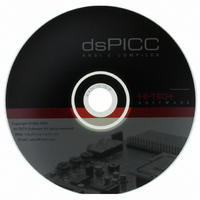SW500009 Microchip Technology, SW500009 Datasheet - Page 134

SW500009
Manufacturer Part Number
SW500009
Description
HI-TECH FOR DSPIC/PIC24
Manufacturer
Microchip Technology
Type
Compilerr
Series
PIC24 & DsPICr
Datasheet
1.SW500009.pdf
(444 pages)
Specifications of SW500009
Supported Families
PIC24
Core Architecture
PIC, DsPIC
Software Edition
Standard
Kit Contents
Software And Docs
Tool Type
Compiler
Mcu Supported Families
PIC24 MCUs And DsPIC DSCs
Lead Free Status / RoHS Status
Not applicable / RoHS Compliant
For Use With/related Products
DSPIC3X/PIC24
Lead Free Status / Rohs Status
Lead free / RoHS Compliant
Other names
025
778-1003
778-1003
778-1003
778-1003
- Current page: 134 of 444
- Download datasheet (3Mb)
Map Files
5.8.2.3 Psect Information listed by Module
The next section in the map file lists those modules that made a contribution to the output, and
information regarding the psects these modules defined.
Under this on the far left is a list of object files. These object files include both files generated from
source modules and those that were extracted from object library files. In the case of those from
library files, the name of the library file is printed before the object file list.
from each object file, and information regarding that psect. This only deals with object files linked
by the linker. P-code modules derived from p-code library files are handled by the code generator,
and do not appear in the map file.
is running. (The Load address is also shown for those psects that may reside in the HEX file at
120
This section is heralded by the line that contains the headings:
This section shows all the psects (under the Name column) that were linked into the program
The Link address indicates the address at which this psect will be located when the program
The other call tree rooted at intlevel1 relates to the interrupt function. intlevel1
is not a real function, but is used to represent the interrupt level associated with the
interrupt function. There is no call from intlevel1 to the function isr and no stack
usage. Note that an additional level of call depth is indicated for interrupt functions.
This is used to mark the place of the return address of the stack. The selected device
may use a differing number of stack locations when interrupts occur and this needs to
be factored into any stack calculations.
Notice that the interrupt function isr calls a function called i1ldiv. This is a du-
plicate of the ldiv routine that is callable by functions under the intlevel1 call tree.
Having duplicate routines means that these implicitly called assembly library routines
can safely be called from both code under the main call tree and code under the interrupt
tree. Pro compilers will have as many duplicates of these routines as there are interrupt
levels.
The call graph shows that the functions: main, byteconv, srv, convert, isr and
i1ldiv are all consuming APB memory that does not fully overlap with that of other
functions. Reducing the auto/parameter memory requirements for these functions will
reduce the program’s memory requirements. The call graph reveals that 82 bytes of
memory are required by the program for autos and parameters, but that only 58 are re-
served and used by the program. The difference shows the amount of memory saved by
overlapping of these blocks by the linker.
Name
Link Load Length Selector Space Scale
Linker and Utilities
Related parts for SW500009
Image
Part Number
Description
Manufacturer
Datasheet
Request
R

Part Number:
Description:
Manufacturer:
Microchip Technology Inc.
Datasheet:

Part Number:
Description:
Manufacturer:
Microchip Technology Inc.
Datasheet:

Part Number:
Description:
Manufacturer:
Microchip Technology Inc.
Datasheet:

Part Number:
Description:
Manufacturer:
Microchip Technology Inc.
Datasheet:

Part Number:
Description:
Manufacturer:
Microchip Technology Inc.
Datasheet:

Part Number:
Description:
Manufacturer:
Microchip Technology Inc.
Datasheet:

Part Number:
Description:
Manufacturer:
Microchip Technology Inc.
Datasheet:

Part Number:
Description:
Manufacturer:
Microchip Technology Inc.
Datasheet:










